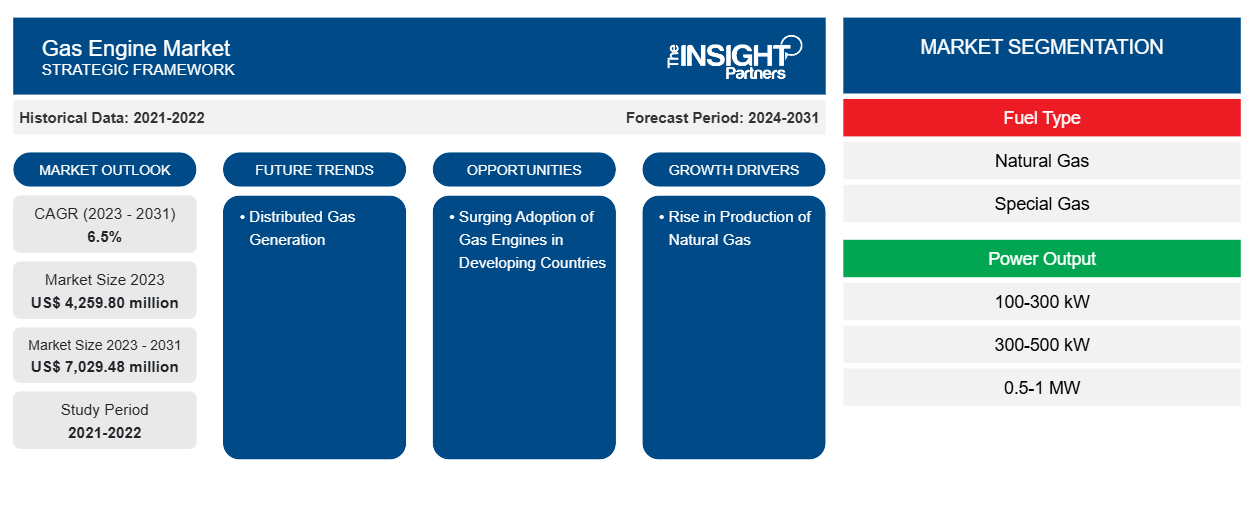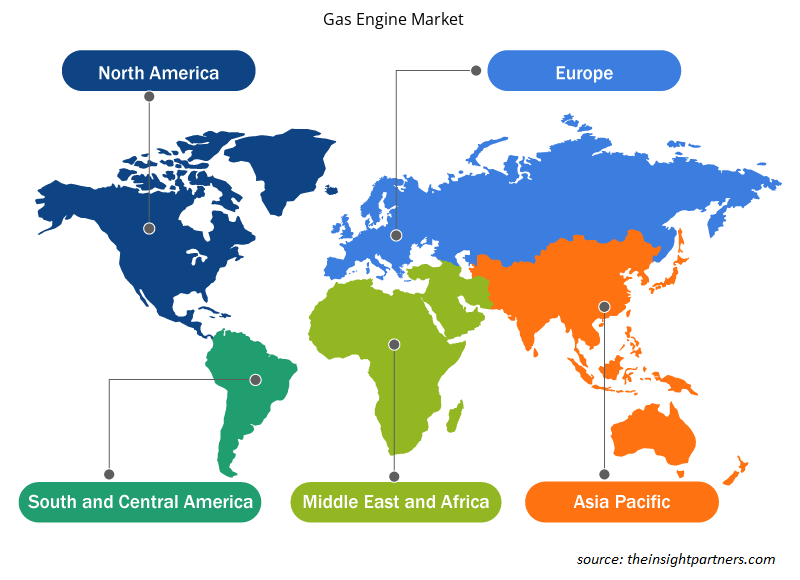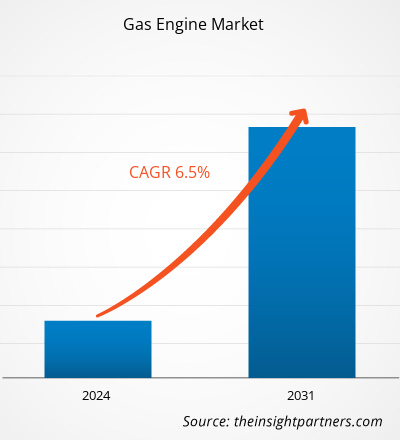Si prevede che il mercato dei motori a gas raggiungerà gli 8.095,93 milioni di dollari entro il 2031, rispetto ai 5.298,16 milioni di dollari del 2024. Si stima che il mercato registrerà un CAGR del 6,4% nel periodo 2025-2031. La crescente domanda di energia a livello mondiale porterà probabilmente nuove tendenze nel mercato nei prossimi anni.
Analisi del mercato dei motori a gas
La crescente attenzione allo sviluppo di motori a combustibile efficienti è uno dei fattori chiave che guidano la crescita del mercato globale dei motori a gas . Inoltre, si prevede che la crescente produzione di gas naturale e le attività di esplorazione e produzione in tutto il mondo stimoleranno ulteriormente la domanda di motori a gas durante il periodo analizzato. Si prevede inoltre che i crescenti incentivi governativi per la transizione verso l'energia pulita in tutto il mondo creeranno ulteriori opportunità per i principali attori del mercato.
Panoramica del mercato dei motori a gas
L'industria manifatturiera dei motori a gas si sta evolvendo con innovazioni nell'offerta di motori a gas naturale per supportare gli obiettivi di emissione. La crescente domanda di motori a basse emissioni ed efficienti nei consumi per ridurre l'inquinamento atmosferico e l'avvento di motori a gas speciali nei settori manifatturiero, dei servizi pubblici e della generazione remota stimolano la crescita del mercato dei motori a gas. Inoltre, i motori alimentati a biogas con una migliore efficienza elettrica e basse emissioni stanno creando notevoli opportunità di crescita per gli operatori del mercato. I produttori di motori a gas si stanno concentrando sull'offerta di prodotti avanzati per soddisfare la crescente domanda di elevate potenze, conformi agli standard dei motori diesel. Le principali industrie pesanti, le centrali elettriche remote e le aziende manifatturiere stanno scegliendo motori a gas ad alta potenza grazie alla maggiore efficienza elettrica e alla riduzione dei costi del carburante. L'uso del gas naturale nella tecnologia di combustione dei motori a gas può risolvere i problemi di emissione, oltre ad aiutare i clienti a soddisfare le nuove normative. Si registra un aumento nell'adozione di motori a gas in Sud America, Africa e Asia, mentre Nord America ed Europa si stanno concentrando sull'adozione dell'energia solare ed eolica durante il periodo di previsione. La crescente adozione del gas naturale per la produzione di energia nei settori commerciale, industriale ed edile sta supportando la crescita del mercato dei motori a gas.
Personalizza questo report in base alle tue esigenze
Riceverai la personalizzazione gratuita di qualsiasi report, incluse parti di questo report, analisi a livello nazionale, pacchetto dati Excel e potrai usufruire di fantastiche offerte e sconti per start-up e università.
Mercato dei motori a gas: approfondimenti strategici

-
Scopri le principali tendenze di mercato di questo rapporto.Questo campione GRATUITO includerà analisi di dati che spaziano dalle tendenze di mercato alle stime e alle previsioni.
Driver e opportunità del mercato dei motori a gas
Maggiore attenzione allo sviluppo di motori a combustibile efficienti
Diversi governi stanno imponendo normative per controllare le emissioni dei motori diesel e a benzina, costringendo i produttori di motori a optare per soluzioni di alimentazione alternative come il gas naturale. I motori a gas rilasciano meno emissioni rispetto ad altri tipi di motore, garantendo una quantità di energia sufficiente. Gli enti di monitoraggio e regolamentazione delle emissioni stanno imponendo normative rigorose sull'uso di motori diesel e generatori. Diverse industrie stanno utilizzando motori e generatori a gas per la produzione di energia elettrica al fine di soddisfare questi standard normativi.
Cummins Inc. e Liberty Energy Inc. hanno annunciato il lancio del primo motore a gas naturale a velocità variabile e cilindrata elevata del settore, destinato ad alimentare la piattaforma di fratturazione idraulica digiPrime di Liberty, la cui installazione è prevista per la prima metà del 2025. Questo fa seguito alla partnership strategica tra le due aziende siglata nel giugno 2024, volta a sviluppare congiuntamente tecnologie innovative per il mercato dei completamenti e dei servizi. Il motore a gas naturale Cummins HSK78G, inizialmente introdotto nel marzo 2019 come parte di un gruppo elettrogeno a velocità fissa per il settore della generazione di energia, ha dimostrato un'affidabilità eccezionale nel fornire potenza costante in diverse fonti di gas naturale e ambienti operativi. I recenti progressi nella piattaforma digiPrime di Liberty utilizzano il motore HSK78G e ne migliorano i tempi di risposta e l'accettazione del carico. Questa collaborazione rappresenta un passo significativo nella continua crescita del mercato dei motori a gas, che continua a innovare in termini di efficienza e prestazioni operative, in particolare in settori come la fratturazione idraulica e la produzione di energia. Pertanto, l'aumento dello sviluppo di motori a carburante efficiente, dovuto alle severe normative relative ai motori a gas, sta stimolando la crescita del mercato.
Incentivi governativi per la transizione verso l'energia pulita
I governi stanno supportando sempre di più la transizione verso fonti energetiche più pulite nell'ambito dei loro più ampi obiettivi di sostenibilità ambientale. Questo è fondamentale per la spinta globale verso la decarbonizzazione e la riduzione delle emissioni di gas serra. I governi prevedono diversi incentivi, sussidi e agevolazioni fiscali per incoraggiare l'adozione di tecnologie più pulite e più efficienti dal punto di vista energetico. I motori a gas, rappresentando un'alternativa più pulita al carbone e al petrolio, sono ben posizionati per beneficiare di queste politiche di sostegno. Ad esempio, la crescente enfasi su soluzioni pulite ed efficienti dal punto di vista energetico nei trasporti ha portato allo sviluppo di diversi programmi di sovvenzioni governative volti a sostenere la transizione delle flotte di trasporto pubblico verso tecnologie sostenibili. La Federal Transit Administration (FTA) ha svolto un ruolo significativo attraverso i suoi programmi Low-No Emission e Bus Facilities Grants. Questi finanziamenti sono specificamente progettati per aiutare le aziende di trasporto pubblico nella transizione delle loro flotte verso alternative più pulite ed efficienti dal punto di vista energetico, come il gas naturale rinnovabile (RNG). Dal 2022, la FTA ha stanziato oltre 500 milioni di dollari per finanziare diversi progetti sul gas naturale, compensando significativamente le spese in conto capitale delle aziende e facilitando l'adozione di tecnologie per l'energia pulita. Questi sussidi federali, in particolare nel settore dei trasporti, promuovono l'uso di autobus e veicoli alimentati a gas naturale, che sono sempre più considerati un'alternativa valida ed ecologica alle opzioni alimentate a gasolio e benzina.
Analisi della segmentazione del rapporto di mercato dei motori a gas
I segmenti chiave che hanno contribuito alla derivazione dell'analisi di mercato dei motori a gas sono il tipo di carburante, la potenza in uscita, l'utente finale e l'applicazione.
- In termini di tipo di carburante, il mercato è suddiviso in gas naturale e gas speciale. Il segmento del gas naturale ha dominato la quota di mercato dei motori a gas nel 2024.
- In base alla potenza, il mercato è suddiviso in 100-300 kW, 300-500 kW, 0,5-1 MW, 1-2 MW, 2-5 MW, 5-10 MW e 10-15 MW. Il segmento 5-10 MW ha dominato il mercato nel 2024.
- In base all'utente finale, il mercato è suddiviso in generazione di energia a distanza, midstream petrolifero e del gas, industria pesante, manifatturiero leggero, servizi di pubblica utilità, biogas, data center, MUSH e commerciale. Il segmento dell'industria pesante ha dominato il mercato nel 2024.
Analisi della quota di mercato dei motori a gas per area geografica
Il mercato dei motori a gas è segmentato in cinque regioni principali: Nord America, Europa, Asia-Pacifico (APAC), Medio Oriente e Africa (MEA) e Sud e Centro America (SAM). L'Europa ha dominato il mercato nel 2024, seguita da Asia-Pacifico e Nord America.
Il mercato dei motori a gas in Europa è segmentato in Germania, Francia, Regno Unito, Russia e Italia. L'Europa è leader nell'adozione di soluzioni energetiche rinnovabili e il passaggio a fonti energetiche più pulite sta dando un forte impulso al mercato dei motori a gas. Paesi come Germania, Italia e Regno Unito stanno passando a soluzioni energetiche più sostenibili, integrando gas naturale e idrogeno nelle loro strategie per l'energia verde. Il recente lancio da parte di MWM del motore della serie TCG 3020, in grado di utilizzare una miscela di idrogeno, riflette l'attenzione del continente sull'idrogeno e sul gas naturale come fonti energetiche future. Inoltre, l'impegno del Regno Unito per la neutralità carbonica entro il 2050 e i suoi investimenti nella tecnologia dei motori a gas dimostrano la crescente domanda di tecnologie efficienti dal punto di vista energetico e a basse emissioni. Gli ambiziosi obiettivi dell'Unione Europea per la riduzione delle emissioni entro il 2030 alimentano ulteriormente la domanda di motori a gas naturale nella produzione di energia, nei trasporti e nelle applicazioni industriali.
Approfondimenti regionali sul mercato dei motori a gas
Le tendenze e i fattori regionali che influenzano il mercato dei motori a gas durante il periodo di previsione sono stati ampiamente spiegati dagli analisti di Insight Partners. Questa sezione illustra anche i segmenti e la geografia del mercato dei motori a gas in Nord America, Europa, Asia-Pacifico, Medio Oriente e Africa, e Sud e Centro America.

- Ottieni i dati specifici regionali per il mercato dei motori a gas
Ambito del rapporto sul mercato dei motori a gas
| Attributo del report | Dettagli |
|---|---|
| Dimensioni del mercato nel 2024 | 5.298,16 milioni di dollari USA |
| Dimensioni del mercato entro il 2031 | 8.095,93 milioni di dollari USA |
| CAGR globale (2025-2031) | 6,4% |
| Dati storici | 2021-2023 |
| Periodo di previsione | 2025-2031 |
| Segmenti coperti |
Per tipo di carburante
|
| Regioni e paesi coperti |
America del Nord
|
| Leader di mercato e profili aziendali chiave |
|
Densità degli operatori del mercato dei motori a gas: comprendere il suo impatto sulle dinamiche aziendali
Il mercato dei motori a gas è in rapida crescita, trainato dalla crescente domanda degli utenti finali, dovuta a fattori quali l'evoluzione delle preferenze dei consumatori, i progressi tecnologici e una maggiore consapevolezza dei vantaggi del prodotto. Con l'aumento della domanda, le aziende stanno ampliando la propria offerta, innovando per soddisfare le esigenze dei consumatori e sfruttando le tendenze emergenti, alimentando ulteriormente la crescita del mercato.
La densità degli operatori di mercato si riferisce alla distribuzione delle imprese che operano in un determinato mercato o settore. Indica quanti concorrenti (operatori di mercato) sono presenti in un determinato spazio di mercato in relazione alle sue dimensioni o al suo valore totale.
Le principali aziende che operano nel mercato dei motori a gas sono:
- INNIO
- Caterpillar Inc
- Cummins Inc
- Fairbanks Morse, LLC
- Kawasaki Heavy Industries Ltd
- Liebherr
Disclaimer : le aziende elencate sopra non sono classificate secondo alcun ordine particolare.

- Ottieni una panoramica dei principali attori del mercato dei motori a gas
Notizie e sviluppi recenti sul mercato dei motori a gas
Il mercato dei motori a gas viene valutato raccogliendo dati qualitativi e quantitativi a valle di ricerche primarie e secondarie, che includono importanti pubblicazioni aziendali, dati di associazioni e database. Di seguito sono elencati alcuni degli sviluppi chiave nel mercato dei motori a gas:
- INNIO Group annuncia il suo ultimo aggiornamento del motore Waukesha VHP P9390X, progettato per un funzionamento più semplice e una maggiore affidabilità. L'aggiornamento del VHP P9390X offre agli operatori la più recente tecnologia motoristica, prolungando la durata delle attrezzature del 60%, riducendo al contempo i tempi di fermo e le emissioni in diverse condizioni operative. (Fonte: INNIO Group, comunicato stampa, settembre 2024)
- Mitsubishi Heavy Industries Engine & Turbocharger, Ltd. (MHIET), parte del gruppo Mitsubishi Heavy Industries (MHI), ha lanciato SGP M2000, un nuovo sistema di cogenerazione con motore a gas naturale con una potenza di 2.000 kW. Il nuovo pacchetto comprende un motore a gas naturale a 16 cilindri, modello G16NB, che vanta un'efficienza elettrica del 44,3%, la più alta al mondo per un motore da 2.000 kW, e costituisce un sistema di cogenerazione dal design compatto. (Fonte: Mitsubishi Heavy Industries, comunicato stampa, marzo 2023)
Copertura e risultati del rapporto sul mercato dei motori a gas
Il rapporto "Dimensioni e previsioni del mercato dei motori a gas (2021-2031)" fornisce un'analisi dettagliata del mercato che copre le aree indicate di seguito:
- Dimensioni e previsioni del mercato dei motori a gas a livello globale, regionale e nazionale per tutti i principali segmenti di mercato coperti dall'ambito
- Tendenze del mercato dei motori a gas, nonché dinamiche di mercato come conducenti, restrizioni e opportunità chiave
- Analisi PEST e SWOT dettagliate
- Analisi del mercato dei motori a gas che copre le principali tendenze del mercato, il quadro globale e regionale, i principali attori, le normative e i recenti sviluppi del mercato
- Analisi del panorama industriale e della concorrenza che copre la concentrazione del mercato, l'analisi della mappa di calore, i principali attori e gli sviluppi recenti per il mercato dei motori a gas
- Profili aziendali dettagliati
- Analisi storica (2 anni), anno base, previsione (7 anni) con CAGR
- Analisi PEST e SWOT
- Valore/volume delle dimensioni del mercato - Globale, Regionale, Nazionale
- Industria e panorama competitivo
- Set di dati Excel
Report recenti
Rapporti correlati
Testimonianze
Motivo dell'acquisto
- Processo decisionale informato
- Comprensione delle dinamiche di mercato
- Analisi competitiva
- Analisi dei clienti
- Previsioni di mercato
- Mitigazione del rischio
- Pianificazione strategica
- Giustificazione degli investimenti
- Identificazione dei mercati emergenti
- Miglioramento delle strategie di marketing
- Aumento dell'efficienza operativa
- Allineamento alle tendenze normative






















 Ottieni un campione gratuito per - Mercato dei motori a gas
Ottieni un campione gratuito per - Mercato dei motori a gas